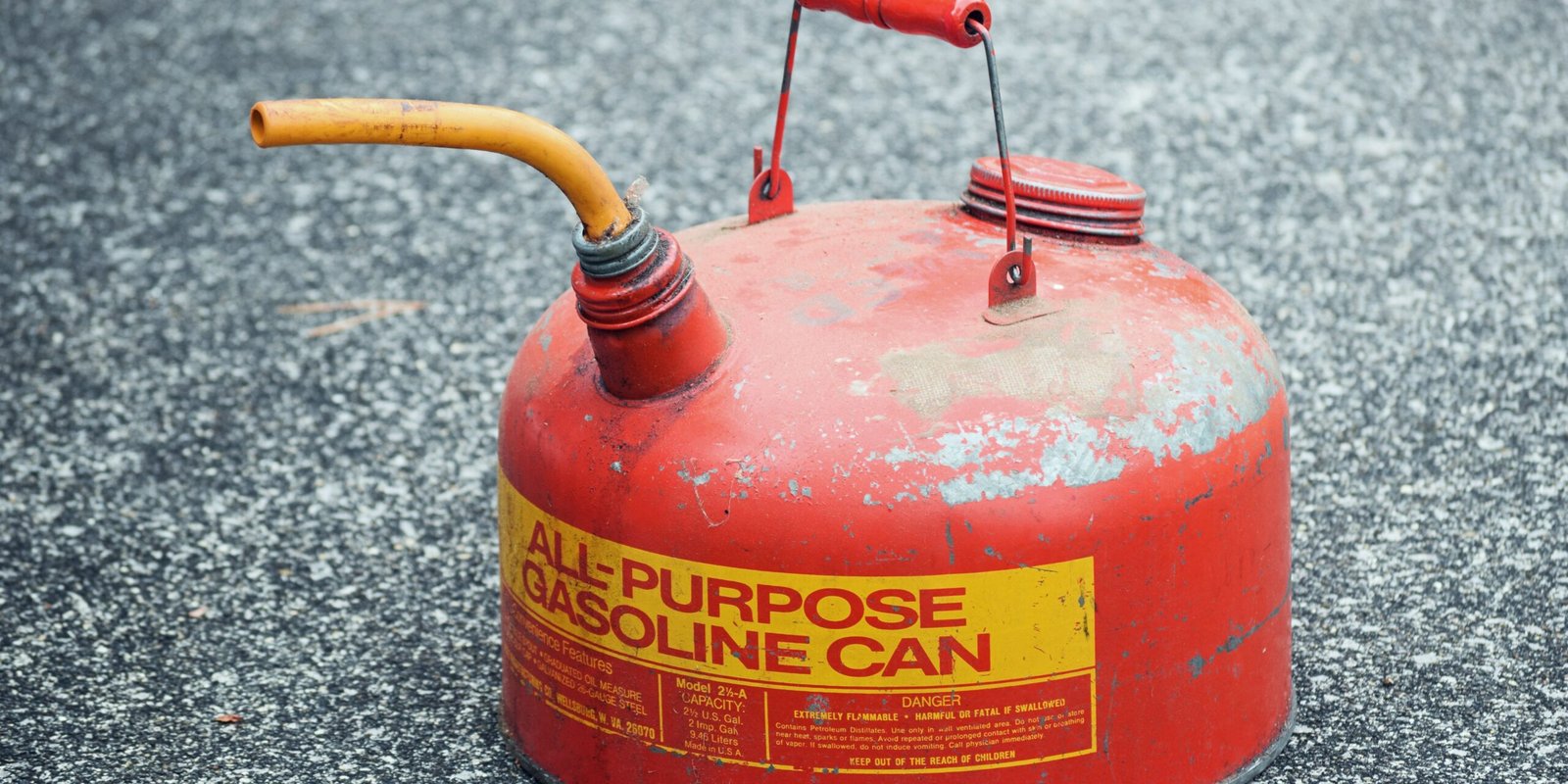How To Store Gas Long Term: 6 Factors To Consider When Storing Fuel Safely
This post may contain affiliate links, full disclosure here.
Fuel is an essential part of our daily lives, especially if you live off the grid. It not only powers your car but also most likely your entire household, from lights to microwaves to shower heating. When an emergency situation arises, it is best to be well-stocked and prepared. Gas is a highly flammable substance, and only rudimentary safety precautions are required to avoid the most common problems.
Long-term gas storage necessitates proper containment – both plastic and metal are acceptable, though metal is preferred. Be cautious of vapor spread, which can pose both inhalation and an ignition risk.
Gas deteriorates over time due to factors such as water dilution, and even container materials deteriorate over time.
The first thing you’ll need are the right tools for the job, followed quickly by methods to keep those tools from becoming obsolete – or, at the very least, to swap them out comfortably before that point.
See also: Top 20 Barter Items to Stockpile
Storing Gas Long Term
Get Proper Containers
Dedicated fuel storage containers are fairly common, with one of the more common methods, such as the jerry can, costing around $40. When purchasing your containers, look for manufacturer markings that indicate compliance with safety standards.
Another important factor to consider when choosing a pouring vessel is funnel compatibility. If these do not form complete seals, fuel will leak out and vapors will enter the air. At best, this would contaminate fuel efficiency and make people in the area ill, and at worst, it could easily lead to severe chemical burns that could spread.
A large, dedicated storage unit could also be installed on one’s property. This way, you could siphon off fuel only as needed, using smaller containers for regular daily use.
Always make certain that the tank you’re using has been safely approved by qualified manufacturers. Label your container and keep it at least fifty feet away from any source of ignition or light.
Typically, residential rules limit gasoline storage to no more than 25 gallons. Given gasoline’s expected shelf life of three to six months, this amounts to a sufficient supply. Performance degrades significantly after this point.
Clogged injectors, stuttering engines, and unreliable generator use are all common problems caused by old gas, putting your expensive hardware at risk.
Another significant issue that many people have is the common gas canister formats. New discoveries in the fuel canister industry appear to have regressed, with common complaints on newer models being poor flow, brittle nozzles, or the lack of fuel can vent for pouring.
Despite all of the alleged innovative anti-spill measures, spillage is a very common complaint about this product line.
Because of their simpler designs and rugged reliability, the general consensus among those who use these is heavily skewed toward older model fuel containers.
Before you do so, make sure to check your state’s legislation, as regulations vary greatly. Some older designs may even be illegal in your city, so do your research before dealing with the red tape.
See also: How A Portable Generator Exhaust Temperature Feature Works
Materials
There are numerous material types suitable for gas storage, each with its own set of advantages and disadvantages. Weight, price, corrosion resistance, recyclability, and pliability are all common considerations.
Plastic is a solid go-to option because it is one of the least expensive safe storage materials on the market. They are lighter and less heat conducive than their counterparts, and any deformations in the material can be quickly hammered out or patched. They are also safer in emergency situations, only melting–steel drums explode in similar circumstances.
The porous nature of plastics is a significant disadvantage. As a result, they absorb vapors from the gasoline, causing structural compromises to develop over time. While these issues will be simple to address, for the time being, the exposure will eventually render the entire container obsolete. Because of their exposure, they are not recyclable, unlike the other materials listed below.
Steel can also be considered a viable option. In fact, jerry cans are frequently made of pressed steel and have earned a trustworthy reputation over time. Steel is also non-porous, so the fuel will not alter the structure of your container.
Unfortunately, the opposite is not true – rust caused by oxidation will restrict fuel flow or cause engine problems. Gasoline consumption is dependent on a very specific fuel-to-air ratio, and even minor contaminants such as rust will have a negative impact on this specific reaction.
Another advantage is that steel is extremely durable, which prevents chip or scratch damage that other storage methods may experience. While container warping can cause difficult or irreversible damage, it takes a long tenure or extreme usage to get there, and you could simply recycle the material to recoup some semblance of return.
Aluminum and fiberglass are two other industrially approved gasoline materials. These two strike a comfortable middle ground in terms of corrosive resistance, weight, and durability, but the materials are typically twice or three times as expensive as comparable steel. Their price tag may be prohibitively expensive for most normal budgets.
Seal
The volatility of gasoline is due to its easily combustible nature and rapid vaporization. Any gaps in your storage unit are not only dangerous, but they are also difficult to detect.
Because of the trapped vapors, a properly done seal frequently causes the container to swell. This isn’t necessarily a bad thing, and it serves as an indication of how airtight the container is. When exposed to heat, however, the container may swell even more or even explode under certain conditions. This is a relatively common concern with steel containers, but it is usually harmless in the absence of heat.
Regardless of material, make sure your container comes from a reputable brand that complies with all health and safety regulations. Saving money on storage containers can result in wasted fuel and additional damage, which can often cost more than the initial purchase price.
Find a Good, Protected Spot
When storing your fuel containers, keep them as far away from potential ignition or heat sources as possible. As previously stated, a distance of about fifty feet will suffice.
is made up of hydrocarbons, which when inhaled can seriously impair the functioning of your nervous system. Dizziness, shortness of breath, and general weakness are common symptoms of gas inhalation. It could even cause unconsciousness and organ failure. Never keep gasoline in your home – the vapors are far too dangerous, whether ignited or not.
Gas containers must be stored in a well-ventilated area. While vapors are a serious issue, open circulation allows you to detect leaks faster and prevent dangerous gas pockets from becoming explosive. Basements and other underground storage areas should be reconsidered because gas can easily become trapped without anyone knowing.
Because light sources are required in underground areas, there are more potential sources of ignition. Aim for a location above ground, preferably where ambient lighting will suffice for the majority of the day. It’s important to remember that gasoline vapour is heavier than air, travels low to the ground, and can be difficult to detect.
To summarise, avoid sources of electricity, ignition, sparks, or even heat. Keep in mind that gasoline is highly flammable and can ignite at any time.
The ideal storage location would be somewhere remote from your home but protected from the elements. Large, above-ground structures, such as barns or sheds, can serve this purpose well. Another option is to custom-design an enclosed cabinet to meet your fuel storage requirements.
Examine the Vessel or the Fuel for Degradation
Storage containers made of plastic and metal degrade in different ways.
Because plastic containers are made of hydrocarbons, just like gasoline, their structural integrity deteriorates over time. Like eventually dissolves like, and using plastic storage necessitates the purchase of more replacement containers. Plastic containers will melt along with their contents in damaged conditions.
They’re also more prone to wear and tear. In light of the effects of gasoline on their structural integrity, it is prudent to inspect your plastic storage containers for cracks and indents on a regular basis. Check for damage at least every couple of months.
Steel is resistant to these issues, but it can jeopardize the fuel itself. Rust can form on steel in as little as a week or two. This is exacerbated further by heat and moisture, which isn’t helped by how well steel conducts heat. Rust in gasoline, as previously stated, will harm engines and generators.
Steel drums are safer to store for an extended period of time. Rust is relatively easy to manage with regular maintenance, whereas plastic degradation requires the complete replacement of the unit. Even in rare cases where the steel barrel cannot be used as is, the metal used can be recycled.
Keep an eye out for water dilution over time
Water dilution can be caused by something as simple as humidity and can result in a harmful process known as phase separation. This situation arises as a result of the presence of ethanol in gasoline. The introduced water binds to the ethanol molecules, causing them to sink to the bottom of the container.
This results in two layers: the original gas layer and a water-ethanol hybrid layer at the bottom. Engines and generators can accommodate the former layer just fine, but the latter causes significant mechanical damage in vehicle engines. Because of the initial appearance of the top layer, this problem is difficult to detect unless specifically checked for.
To avoid rust and phase separation issues, try to keep your storage area as dry as possible. Plants could be kept in a storage area. They also serve as early warning indicators for gasoline vapor leaks, as exposure to such asphyxiates their roots, resulting in visible discoloration and rot.
Fuel Stabalizers
While gasoline has a relatively short initial shelf life, there are products on the market that can significantly extend its potency. The purpose of fuel stabilizers is to reduce moisture buildup, evaporation, and varnish residue. These can increase the shelf life of your gasoline from six months to two years.
When using fuel stabilizers, make sure to use the correct product for gasoline. Some variants are only applicable to diesel engines, and using them could result in all sorts of engine complications that you were attempting to avoid.
Only use fuel stabilizers when you’re using gasoline. Directions for the procedure will always be provided, and you should only need a small amount for the amount of fuel you want to re-energize. The STA-BIL product line is one of the more well-known brands among thousands of users.
Carbureted engines, in particular, require this when dealing with old gasoline. Evaporation thickens your fuel over time, especially after years of storage. Adding a fuel stabilizer revitalizes it and makes it suitable for most engines.
Rotate Your Gasoline Stock
If you don’t like the idea of using additives or other hardcore dedicated storage methods, simply rotating your gasoline stock should suffice. Gas, in its current state, lasts about half a year before its quality begins to deteriorate significantly, and given the expected 25-gallon limit most counties adhere to, you’ll likely burn through the majority of that in the course of your daily life.
Simply label your main storage options in the order in which they were purchased, and then go through the tanks in that order, beginning with the oldest tank you have. If you’re only going off the grid for a few months, regular gasoline has a shelf life of three to six months without any additives.
Even minor emergencies are usually resolved in two months or less, so unless societal collapse is imminent, simply rotating your gasoline cache by purchase order will suffice. That being said, don’t dismiss the possibility entirely – keep some bug-out plans in your back pocket just in case.
How To Store Gas Long Term Bottom Line
Gas is one of the more difficult fuels to store because it has a shorter shelf life and higher volatility than most of its competitors. If you’re up to it, gas is a great fuel that will last as long as you need it to. The majority of their safety precautions are shared with other fuel types; the level of danger only differs. Just make sure you have the right tools and that you handle them carefully.







